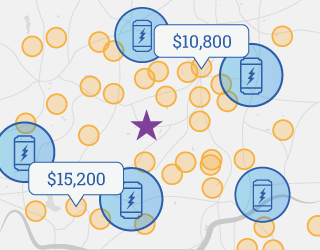As more and more customers express interest in solar plus storage on EnergySage’s Marketplace, many do so with the same intended purpose: resiliency. When the grid goes dark, these solar shoppers want to ensure that they are on an electric “island” to keep their own lights on, self-generating and storing solar electricity that they can then consume. The solution? Microgrids.
Partially in response to major storm events nationwide, this innovative, if not new, approach is being taken throughout the country to maintain greater reliability and to return power quicker at the local level. By taking the notion of an electrical island from a single home to multiple buildings or an entire community, communities, cities, and organizations are creating microgrids.
What is a microgrid?
A microgrid is exactly what it sounds like: a compressed version of the larger electrical grid that powers our country. The electrical grid exists to supply our electricity demand, ensuring that the two are balanced and connecting electrical supply to electrical demand with the transmission and distribution system. In practice, a microgrid works in the exact same way, just for a smaller geographic area, like a couple of buildings or a local community.
To meet the electricity demands of its users, a microgrid must have a generation source. Given that microgrids are an older concept, the electricity supplied to microgrids has historically been from “behind the meter” fossil fuel generators – gas-powered generators, for example. However, with the falling cost of solar, not to mention the environmental benefits of switching from fossil fuel generation to solar power, many of the microgrids being designed today supply electricity with a combination of solar plus battery storage.
Microgrids are capable of becoming electrically isolated from the grid in the event of an outage. When the grid goes down due to anything from a severe weather event to a knocked over telephone pole, you need to be disconnected from the grid–or “islanded”–in order to continue to produce and use electricity. As such, one key feature of a microgrid is its ability to continue operating even when the larger grid goes out.
The need for microgrids: where can they be useful?
When Hurricane Maria tore through Puerto Rico in 2017 causing the longest power outage in U.S. history, a lot of press coverage soon after the storm focused on the need to get electricity to hospitals and emergency responders. This turns out to be an ideal use case for a microgrid.
The impact of losing electricity varies widely depending on who or what is losing power. If an individual home loses electricity for a couple of hours, it might be a nuisance, but far from life-threatening. However, a loss of electricity at a hospital is absolutely a life-threatening scenario. Between a higher electric load and an often spread out geographical footprint, it makes sense to create an interconnected network of solar panels and storage to continue to power these types of buildings in the event of an outage. In a word: a microgrid.
There are a number of applications of microgrids, from powering emergency response buildings to providing grid resiliency for communities with a large population of people whose health would be put at risk by a prolonged power outage. In fact, one of the major benefits of a microgrid is that it can extend beyond a single house or building and create a tiny electricity-isolated island within a community. A perfect example of this would be a microgrid between a fire department, a school, and a senior center, which could provide benefits to first responders, the at-risk population, and a possible shelter from the storm all under one interconnected and resilient grid system.
Microgrids in the U.S.
Microgrids are already operational and under development in the U.S. to improve resiliency for different communities. Though different in their individual designs and applications, all of these microgrids share one thing in common: the goal of increasing resiliency.
For instance, in Puerto Rico, a number of solar microgrids have begun to pop up in the aftermath of Hurricane Maria, with a solar microgrid in Humano keeping the lights on during a grid outage a full year after the hurricane hit. Similarly, in California, fire departments are beginning to deploy microgrid technology following 2018’s deadly and costly forest fire season.
Moving forward, microgrids built on solar + storage look set to expand even more rapidly as a part of climate action plans at the local, state and federal levels. The U.S. military already deploys microgrids on military bases throughout the country for strategic purposes, and the Department of Defense is actively implementing renewable-based microgrids on bases. What’s more, individual cities are including microgrids in their climate action plans, such as Boston’s call for neighborhood networks.
Install solar + storage to increase resiliency
Even if your community is not a part of a microgrid, you can take the first step towards improving your own resiliency to major storm events by investing in an islanded solar plus storage system. The EnergySage Marketplace allows you to comparison shop across up to seven free quotes from local, pre-screened solar companies.






